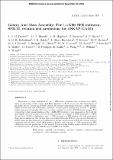Files in this item
Galaxy And Mass Assembly : the 1.4 GHz SFR indicator, SFR-M★ relation and predictions for ASKAP-GAMA
Item metadata
| dc.contributor.author | Davies, L. J. M. | |
| dc.contributor.author | Huynh, M. T. | |
| dc.contributor.author | Hopkins, A. M. | |
| dc.contributor.author | Seymour, N. | |
| dc.contributor.author | Driver, S. P. | |
| dc.contributor.author | Robotham, A. G. R. | |
| dc.contributor.author | Baldry, I. K. | |
| dc.contributor.author | Bland-hawthorn, J. | |
| dc.contributor.author | Bourne, N. | |
| dc.contributor.author | Bremer, M. N. | |
| dc.contributor.author | Brown, M. J. I. | |
| dc.contributor.author | Brough, S. | |
| dc.contributor.author | Cluver, M. | |
| dc.contributor.author | Grootes, M. W. | |
| dc.contributor.author | Jarvis, M. | |
| dc.contributor.author | Loveday, J. | |
| dc.contributor.author | Moffet, A. | |
| dc.contributor.author | Owers, M. | |
| dc.contributor.author | Phillipps, S. | |
| dc.contributor.author | Sadler, E. | |
| dc.contributor.author | Wang, L. | |
| dc.contributor.author | Wilkins, S. | |
| dc.contributor.author | Wright, A. | |
| dc.date.accessioned | 2017-01-20T17:30:08Z | |
| dc.date.available | 2017-01-20T17:30:08Z | |
| dc.date.issued | 2017-04 | |
| dc.identifier | 248191658 | |
| dc.identifier | 155233ed-f06c-4f1b-8e2b-1fc14ce668a0 | |
| dc.identifier | 000398284600078 | |
| dc.identifier | 85040247507 | |
| dc.identifier.citation | Davies , L J M , Huynh , M T , Hopkins , A M , Seymour , N , Driver , S P , Robotham , A G R , Baldry , I K , Bland-hawthorn , J , Bourne , N , Bremer , M N , Brown , M J I , Brough , S , Cluver , M , Grootes , M W , Jarvis , M , Loveday , J , Moffet , A , Owers , M , Phillipps , S , Sadler , E , Wang , L , Wilkins , S & Wright , A 2017 , ' Galaxy And Mass Assembly : the 1.4 GHz SFR indicator, SFR-M ★ relation and predictions for ASKAP-GAMA ' , Monthly Notices of the Royal Astronomical Society , vol. 466 , no. 2 , pp. 2312-2324 . https://doi.org/10.1093/mnras/stw3080 | en |
| dc.identifier.issn | 0035-8711 | |
| dc.identifier.other | crossref: 10.1093/mnras/stw3080 | |
| dc.identifier.uri | https://hdl.handle.net/10023/10139 | |
| dc.description.abstract | We present a robust calibration of the 1.4 GHz radio continuum star formation rate (SFR) using a combination of the Galaxy And Mass Assembly (GAMA) survey and the Faint Images of the Radio Sky at Twenty-cm (FIRST) survey. We identify individually detected 1.4 GHz GAMA–FIRST sources and use a late-type, non-active galactic nucleus, volume-limited sample from GAMA to produce stellar mass-selected samples. The latter are then combined to produce FIRST-stacked images. This extends the robust parametrization of the 1.4 GHz–SFR relation to faint luminosities. For both the individually detected galaxies and our stacked samples, we compare 1.4 GHz luminosity to SFRs derived from GAMA to determine a new 1.4 GHz luminosity-to-SFR relation with well-constrained slope and normalization. For the first time, we produce the radio SFR–M* relation over 2 decades in stellar mass, and find that our new calibration is robust, and produces a SFR–M* relation which is consistent with all other GAMA SFR methods. Finally, using our new 1.4 GHz luminosity-to-SFR calibration we make predictions for the number of star-forming GAMA sources which are likely to be detected in the upcoming Australian Square Kilometre Array Pathfinder surveys, Evolutionary Map of the Universe and Deep Investigation of Neutral Gas Origins. | |
| dc.format.extent | 1008495 | |
| dc.language.iso | eng | |
| dc.relation.ispartof | Monthly Notices of the Royal Astronomical Society | en |
| dc.subject | Galaxies: star formation | en |
| dc.subject | Galaxies: evolution | en |
| dc.subject | Radiation mechanisms: non-thermal | en |
| dc.subject | Radiation continuum: galaxies | en |
| dc.subject | QB Astronomy | en |
| dc.subject | QC Physics | en |
| dc.subject | 3rd-DAS | en |
| dc.subject.lcc | QB | en |
| dc.subject.lcc | QC | en |
| dc.title | Galaxy And Mass Assembly : the 1.4 GHz SFR indicator, SFR-M★ relation and predictions for ASKAP-GAMA | en |
| dc.type | Journal article | en |
| dc.contributor.institution | University of St Andrews. School of Physics and Astronomy | en |
| dc.identifier.doi | 10.1093/mnras/stw3080 | |
| dc.description.status | Peer reviewed | en |
This item appears in the following Collection(s)
Items in the St Andrews Research Repository are protected by copyright, with all rights reserved, unless otherwise indicated.

